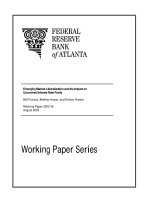Brand Breakout - How Emerging Market Brands Will Go Global
Bạn đang xem bản rút gọn của tài liệu. Xem và tải ngay bản đầy đủ của tài liệu tại đây (3.35 MB, 643 trang )
“Brand Breakout is a must-read, not only for
those who run local companies and brands
expanding internationally, but for all of us
who compete against them in their own ter-
ritories, and are compelled to win with global
brands and strategies against a variety of
very local realities.”
Juan Alanis, General Manager
The Estée Lauder Companies Inc., Mexico
“As two of the most well-known marketing
scholars on emerging markets in the world,
Nirmalya Kumar and Jan-Benedict Steen-
kamp provide a definitive guideline for
emerging market brands here. The eight
routes proposed in this book lay out a com-
prehensive roadmap for those aspiring com-
panies and countries to effectively enter
global markets, and will have a far-reaching
impact in the years to come. It also provides
great insights on the transition of the eco-
nomic development mode of China. A novel
and thought-provoking masterpiece!”
Yubo Chen, Professor & Deputy
Chair
of Marketing, Tsinghua University
“Outstanding book. It is fascinating and un-
doubtedly a must-read piece for managers in
both Western and emerging market compan-
ies. It was eye-opening to see how Chinese
and other emerging market firms are chan-
ging from a clear focus on manufacturing
and supply chain efficiencies to building
brand equities and allocating enough re-
sources behind them. This is our new com-
petition. It seems they now realize that the
real value of their companies is in their
brands. And it is not until they fully compre-
hend this that the expansion of these brand
3/643
equities can really take place; Corona from
Mexico is a good example.”
Henry Gomez, Vice-President
Business
Development for Latin America, Pepsico
“Emerging market firms are still better at
manufacturing than branding. Brand Break-
out provides CEOs with a timely and system-
atic roadmap of recommendations to change
this.”
John Quelch, Professor, Harvard
Business School & Former
Dean of CEIBS (China Europe International
Business School)
“An encouraging and integral reading about
how emerging markets companies could rap-
idly expand the value of their offering. It re-
cognizes how crucial it becomes to unlock
value through ‘the art’ of brand building with
tangible and relevant principles. Certainly,
leveraging the full potential of the cross-
4/643
cultural diaspora strategy will be fundament-
al for brands determined to thrive in global
markets. An extraordinary book with price-
less insights that every marketing manager
should treasure.”
Leandro Berrone, Marketing VP
Cuauhtémoc Moctezuma, Part of the Heinek-
en Company
5/643
BRAND BREAKOUT
HOW EMERGING
MARKET BRANDS WILL
GO GLOBAL
NIRMALYA KUMAR
JAN-BENEDICT
E.M. STEENKAMP
© Nirmalya Kumar and Jan-Benedict
E.M. Steenkamp 2013
All rights reserved. No reproduction,
copy or transmission of this publication
may be made without written
permission.
No portion of this publication may be
reproduced, copied or transmitted save
with written permission or in accord-
ance with the provisions of the Copy-
right, Designs and Patents Act 1988, or
under the terms of any licence permit-
ting limited copying issued by the
Copyright Licensing Agency, Saffron
House, 6–10 Kirby Street, London
EC1N 8TS.
Any person who does any unauthorized
act in relation to this publication may
be liable to criminal prosecution and
civil claims for damages.
The authors have asserted their rights
to be identified as the authors of this
work in accordance with the Copyright,
Designs and Patents Act 1988.
First published 2013 by
PALGRAVE MACMILLAN
Palgrave Macmillan in the UK is an im-
print of Macmillan Publishers Limited,
registered in England, company num-
ber 785998, of Houndmills, Basings-
toke, Hampshire RG21 6XS.
Palgrave Macmillan in the US is a divi-
sion of St Martin’s Press LLC,175 Fifth
Avenue, New York, NY 10010.
8/643
Palgrave Macmillan is the global aca-
demic imprint of the above companies
and has companies and representat-
ives throughout the world.
Palgrave® and Macmillan® are re-
gistered trademarks in the United
States, the United Kingdom, Europe
and other countries.
ISBN: 978–1–137–27661–2
This book is printed on paper suitable
for recycling and made from fully man-
aged and sustained forest sources.
Logging, pulping and manufacturing
processes are expected to conform to
the environmental regulations of the
country of origin.
A catalogue record for this book is
available from the British Library.
9/643
A catalog record for this book is avail-
able from the Library of Congress.
Typeset by Aardvark Editorial Limited,
Metfield, Suffolk
10/643
To MK – emerging market conception,
hopefully on the way
to becoming a global brand
NK
To my father – without whom I would never
have been
where I am now –
and to Valarie – whose love ensures I am
happy where I am
JBS
Also by the Authors
Nirmalya Kumar and Jan-Benedict E. M.
Steenkamp,
Private Label Strategy: How to Meet the
Store Brand Challenge
(Boston: Harvard Business School Press,
2007)
CONTENTS
List of figures
List of tables
Preface
Acknowledgments
Introduction
ONE The Asian Tortoise route: mi-
grating to higher quality and
brand premium
Rise of the Japanese automotive
global brands
Pioneered by Japanese, followed by
South Korea
Key success factors for the Asian Tor-
toise strategy
Haier and higher with the Asian Tor-
toise strategy
Limits of the Asian Tortoise strategy
Managerial takeaways
TWO The business to consumer
route: leveraging B2B
strengths in B2C markets
Understanding B2B companies
From contract manufacturer to con-
sumer brand
A move to adjacent consumer cat-
egories for global B2B firms
Managerial takeaways
THREE The diaspora route: follow-
ing emigrants into the world
Understanding the diaspora
Ethnic affirmers
Biculturals
Diaspora and reverse diaspora
Using the diaspora as a beachhead to
breakout
14/643
Dabur: from diaspora to mainstream
Managerial takeaways
FOUR The brand acquisition route:
buying global brands from
Western multinationals
The rationale for acquiring global
brands
Retain or migrate?
Acquire and migrate
Acquire and retain
Managing acquisitions as a learning
capability
Managerial takeaways
FIVE The positive campaign route:
overcoming negative country-
of-origin associations
Country-of-origin image
Why do country images differ so
much?
The role of country of origin in
consumer decision-making
15/643
Overcoming country-of-origin
disadvantage
Nation/region-branding campaigns
Managerial takeaways
SIX The cultural resources route:
positioning on positive cultur-
al myths
A framework for cultural branding
Cultural meanings
Transfer of cultural meaning to con-
sumer brands
Cultural branding based on ancient
myths
Cultural branding based on contem-
porary myths
Managerial takeaways
SEVEN The natural resources
route: branding commodities
in four steps
Define the geographical region
Specify production standards
16/643
Authenticate ingredients and
processes
Take the brand international
The making of the Café de Colombia
brand
Managerial takeaways
EIGHT The national champions
route: leveraging strong sup-
port from the state
A brief history of national champions
The rationale for national champions
The limits of national champions
When can national champions build
consumer brands?
Emirates Airlines: global brand and
national champion
Managerial takeaways
Conclusion
Appendix
Notes
Index
17/643
LIST OF FIGURES
1.1 Product–brand spectrum
2.1 Different global footprints
2.2
Contrasting the Asian Tortoise and B2B
routes
3.1 Modes of acculturation for the diaspora
3.2
Key success factors leveraging the
diaspora
3.3
Diffusion of the brand in the host
country
4.1 Lenovo IBM ThinkPad migration
4.2 Complementary brand capabilities
5.1
Country image of China and Japan
among US consumers
5.2
The role of country of origin in the con-
sumer decision process
5.3 Quality perceptions of PCs in China
5.4
Intrinsic preferences for country of ori-
gin in the PC industry among Chinese
consumers
5.5 Product–country match
6.1 A model for cultural branding
7.1 Branding natural resources
7.2
Three-year moving average prices of
three types of Arabica coffee
8.1
C3 framework of factors determining
the success of national champions as a
global brand
19/643
LIST OF TABLES
I.1 Eight routes to global brands
1.1 Leading Asian brands, 2012
1.2
The tortoise strategy to build global
brands
2.1
Strategic analysis of the key success
factors for three kinds of companies
2.2 Financial models
4.1 Examples of recent acquisitions
4.2 Two approaches to M&As
5.1
Quality image of products made in vari-
ous countries or regions
6.1 Semiotic analysis of Shanghai Tang
6.2
Product and price analysis of Shanghai
Tang
6.3
Havaianas: brand association pre- and
post-1994
21/643
PREFACE
We are fortunate to have lived through a
remarkable transformation. One of us grew
up in Calcutta, a city that was the byword for
human and economic misery, located in a
country that was almost as segregated from
the world economy as its neighbor, China.
The other, born in Amsterdam, had to study
Asian Drama, a book about the dismal fu-
ture of a continent mired in a downward
spiral of population growth and poverty.
Shortly after publication, its author, Gunnar
Myrdal, was awarded the 1974 Nobel Prize
for Economics. Asian nations as well as those
from Africa and South America were
routinely referred to as underdeveloped
countries, or the more derogatory “Third
World.” The term “emerging markets” was
unknown. Developed countries accounted
for more than 80 percent of world GDP and
world trade. And any global brands like
Coca-Cola and Mercedes that existed were
exclusively from the West.
Fast-forward 50 years. The global eco-
nomic reality under which multinational cor-
porations now operate has changed beyond
the wildest dreams of even the most optim-
istic “Third World” policy-maker of the
1960s. The 1979 opening of China to the
world economy initiated a process that has
led to an accelerated convergence between
nations today. In the intervening years, more
and more of the world has become integrated
with the global economy. As examples, con-
sider the collapse of the Soviet Union, the
1991 economic reforms of India, the fall of
the apartheid regime of South Africa, and the
unfolding opening-up of Myanmar. What
23/643
were previously underdeveloped countries
are now not only emerging markets, but the
central focus of multinational corporations
in their quest for growth.
Our own careers mirror the changing fo-
cus of multinational corporations and their
executives. We met over 20 years ago in the
United States. Since then, we have collabor-
ated on many different research, teaching,
and consulting projects related to global
strategy, marketing, and branding. This book
originated, as have many of our projects,
during a casual conversation over a bottle of
Bordeaux. It began with a question: why
don’t we observe global brands from emer-
ging markets? This predictably led to an ar-
gument on why this is so, with each of us try-
ing to develop a stronger rationale for what
currently exists (or “best practice” in that all
observed global brands are from the de-
veloped nations). But, as always, we did not
stop there. We began imagining “next
24/643
practice” or what is to come. Several hypo-
theses were generated on how emerging
market brands could go global. The outcome
of that debate, with years of research inter-
vening, is this book.
The book was a journey of discovery for
us. Our research led us to voraciously read
books, cases, and articles about emerging
market brands. We made, individually as
well as a team, numerous trips to emerging
markets in order to interview executives who
aspired to build global brands. We observed
companies and factories from Brazil to India,
to South Africa, and of course China. We had
research associates and collaborators in the
Americas, Europe, and Asia to help us gather
data, where and when we were unable to be
there. We learnt about companies we had
never heard of and observed green shoots of
global brands where there had once been ig-
norance on our part.
25/643









